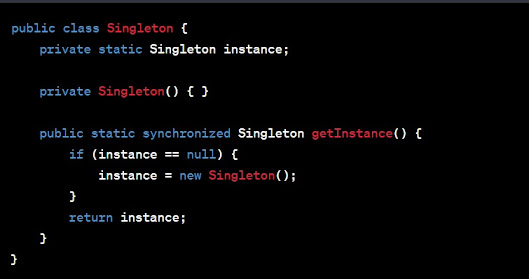Design Patterns And Principles
Design Patterns And Principles
Design patterns are reusable solutions to common problems that occur in software design. They can speed up the development process by providing tested, proven development paradigms, and provide a way for developers to communicate using well-known names for these patterns.
Here's an overview of several important design patterns in Java:
Singleton Pattern: The Singleton Pattern ensures that a class has only one instance and provides a global point of access to it.
Here's a simple example of a Singleton Pattern in Java:

Factory Pattern: The Factory Method Pattern defines an interface for creating an object, but allows subclasses to decide which class to instantiate. The Factory method lets a class defer instantiation to subclasses.
Here's a simple example of a Factory Pattern in Java:
Observer Pattern: The Observer Pattern defines a one-to-many dependency between objects so that when one object changes state, all its dependents are notified and updated automatically.
Here's a simple example of an Observer Pattern in Java:
Strategy Pattern: The Strategy Pattern defines a family of algorithms, encapsulates each one, and makes them interchangeable. Strategy lets the algorithm vary independently from the clients that use it.
Here's a simple example of a Strategy Pattern in Java:
As for principles, the most known in the Java community are the SOLID principles:
Single Responsibility Principle: A class should have one, and only one, reason to change.
Open-Closed Principle: You should be able to extend a classes behavior, without modifying it.
Liskov Substitution Principle: Derived classes must be substitutable for their base classes.
Interface Segregation Principle: Make fine grained interfaces that are client specific.
Dependency Inversion Principle: Depend on abstractions, not on concrete classes.
Each of these principles helps ensure that your code is well-structured and easy to maintain and modify. They can also make it easier to prevent and find bugs in your code. Design patterns and principles are crucial tools in a developer's toolbox, and becoming proficient in them can significantly improve your skills as a developer.
Here is another example with different pattern and principle:
This code demonstrates a number of object-oriented programming principles and design patterns:
Factory Method Pattern: The getAnimal method in the Animal class acts as a factory method to create and return an instance of an Animal subclass based on the type argument.
Abstract Factory Pattern: To some extent, this code can also be seen as an implementation of the Abstract Factory Pattern, with Animal acting as the abstract factory. Each of Dog and SeaHorse classes are concrete factories that produce a family of products (methods speak and liveInHome or liveInWater).
Inheritance and Abstraction: The Animal abstract class is the parent class from which the Dog and SeaHorse classes inherit. They each implement the speak method in their own ways, which is a demonstration of abstraction.
Polymorphism: This principle is demonstrated when the speak method is called. The actual method that gets executed depends on the type of the Animal object at runtime.
Interface Segregation Principle (ISP): This is one of the SOLID principles of object-oriented programming. The code uses two interfaces, Domestic and Sea, to define behavior specific to certain classes (Dog and SeaHorse, respectively). Each class only needs to know about the methods that are relevant to it. This principle states that a class should not be forced to implement interfaces they do not use.
Dependency Inversion Principle (DIP): The Animal class does not depend on the concrete classes Dog and SeaHorse. Instead, all of them depend on abstractions. The Dog and SeaHorse classes are interchangeable as Animal objects. In the main method, a Dog object is even created as a Domestic type, meaning the code depends on the Domestic interface, not on the concrete Dog class. This is a demonstration of DIP.






Comments
Post a Comment